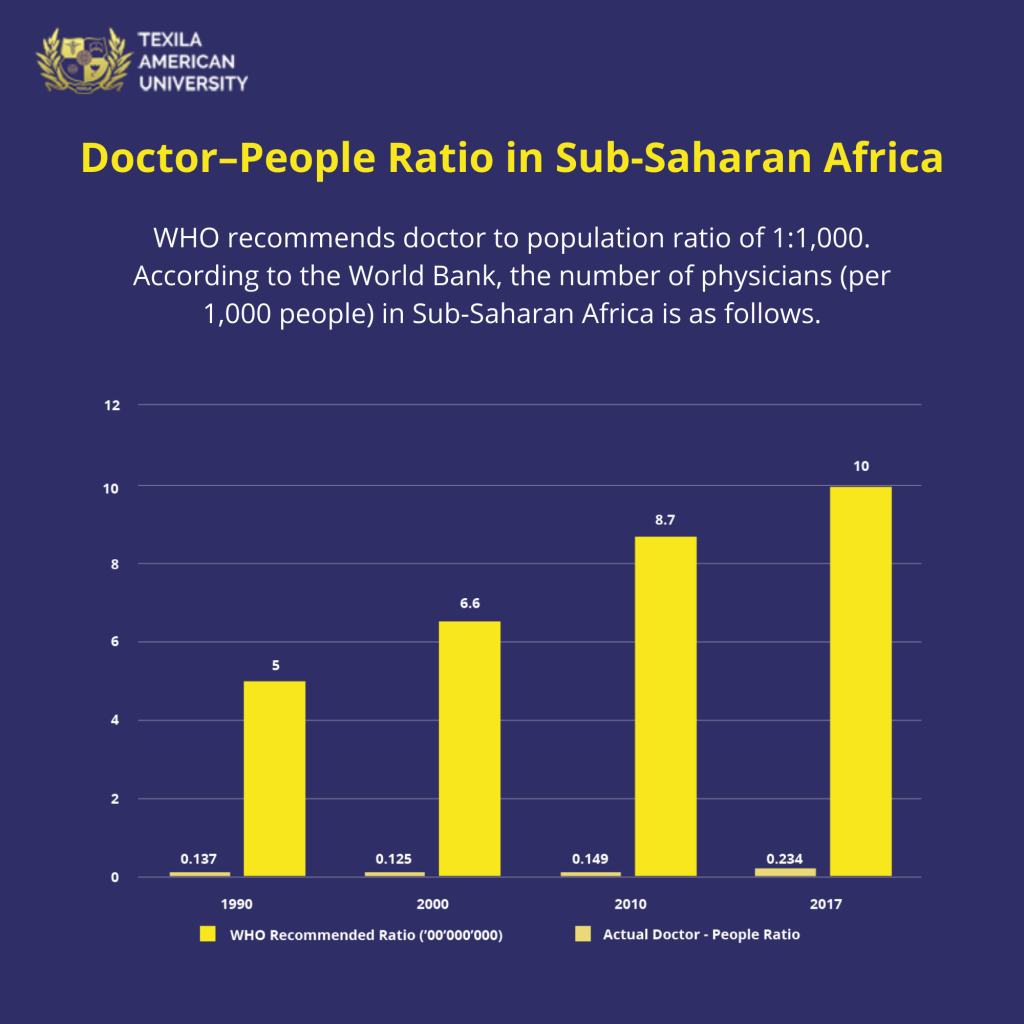|
Tired of Reading? Please listen to the blog
|
Blog Summary
The African population is growing at 2.5% annually, raising the demand for quality and accessible healthcare services to achieve Universal Health Coverage (UHC). Individuals are motivated to pursue a career in healthcare to meet the rising demand. South Africa, Zambia and Zimbabwe offer several opportunities to medical professionals. The African governments use demand forecasting and planning to understand healthcare requirements to make suitable investments and develop policies to overcome the brain drain. Also, increase in pay and social status for healthcare professionals. TAU is one of the leading universities offering various programs in medicine, public health, and management with ultra-modern laboratories and facilities. Enroll for MBChB at TAU, Zambia, and make a brilliant career in healthcare.
How Many Doctors per Person Are There in Africa?
Africa is in pressing need of doctors with 1 doctor for 10,000 people on an average. The shortage of doctors is expected to reach 4.3 million by 2035. In the majority of African countries, the doctor-patient ratio is worrying.
From the above table, you could see which country has the lowest number of doctors. The healthcare crisis in Africa is mainly due to the steady decline in the number of doctors in these countries. A robust medical sector is the backbone of any country, and now, only students who have a passion for medical studies can help resolve this issue plaguing the continent.
This article will complement the concerns related to the shortage of doctors in Africa. According to the latest World Bank and World Health Organization (WHO) statistics. The below sections will highlight the aspects related to the demand for doctors, the increasing demand for medical professionals, and the scenario of the healthcare sector in the continent:
Overview of African Healthcare Sector
In the past, African countries like Kenya and Uganda complained that they are suffering from a brain drain in the medical industry. The citizens residing in the rural regions need to face long treks and queues to avail of any medical assistance. Presently, advanced technologies are incorporated into the healthcare sector to enhance the existing situation for ordinary Africans.
The population in the country is growing at a rapid rate. For the last 20 years, the population has increased yearly by 2.5%, and it is anticipated to elevate to 2.4 billion by 2050. Moreover, the country withstands 25% of the global disease burden and is served by only 2% of the globe’s healthcare workforce.
With the increasing population, there will be a rising demand for excellent quality and effortlessly accessible healthcare services to attain universal health coverage (UHC). The UHC suggest that all people would avail the health services according to their requirement without suffering from financial adversity. If the shortage of doctors is met appropriately, then UHC will succeed in its mission. The target to attain UHC by 2030 was framed in the Sustainable Development Goal (SDG) 3 and served a goal for the continent to work on the same.
Looking at the healthcare scenario in South Africa, it presently executes a two-tiered healthcare system. This system comprises of the public and the small yet rapidly growing private sector. In 2017, the country already spent 9% of its GDP on healthcare, and the same is 4% higher than the WHO’s recommended expenditure for a nation of its socioeconomic status.
Notwithstanding this high expenditure, the health outcomes are not so effective as in the same middle-income countries. The reason behind the same is the discrimination between the public and private sectors.
The development of the Africa healthcare sector is motivated by the:
- Establishment of hospitals or clinics,
- In-country manufacturing,
- Rising options for micro-insurance,
- Enhancement in healthcare delivery,
- Increased number of solutions for serving POC healthcare, and
- Intense focus on home diagnostics.
According to recent research stated in a new report, the IFC approximates that over the upcoming decade, a new Public-Private partnership investment of $25-$30 billion will be required to fulfill Africa’s healthcare demand.
Growing Demand for Medical Professionals in Africa
There are in total of 57 countries with an acute shortage of healthcare workers; these countries have a lack of 2.4 million doctors and nurses. In the African continent, there are 2.3 healthcare workers per 1000 population, while on the other hand, the Americas have around 24.8 healthcare workers per 1000 people.
The investigation of healthcare workers in Africa indicates that workforce deficiency in few countries under study is more upsetting than what is stated initially by the prevailing literature. There are many Sub-Saharan nations in which the workforce needs to be scaled up to 140%. Doing this would achieve international health development targets like those within the Millennium Declaration.
The regions of sub-Saharan Africa have an acute shortage of healthcare workers, with just two doctors and 11 nursing personnel per 10,000 patients. This ratio, in comparison with 19 doctors and 49 nursing personnel in the Americas and with 32 and 78, respectively, in Europe, is daunting. Furthermore, the lack of nephrologists in Africa is also a significant point of concern, with some African countries having less than one nephrologist per million population. In contrast, a few have no nephrologists at all.

Opportunities for Qualified Medical Professionals
However, In Africa, the number of graduating doctors has risen by 18% between 2000 and 2012. Along with this rise, there is a shift from usual gender and racial parity to more females, and African individuals of mixed ancestry. The number of fresh medical students enrolling has risen by 34% from the years 2000 To 2012.
Countries like South Africa, Zambia, and Zimbabwe provide medical professionals with several opportunities, whether in metropolitan or rural settings. They get opportunities to work with a well-trained team of professionals. In the country, one of the best ways to motivate individuals to enter health-related professions is by targeting the education field. After completing the relevant medical education, the graduates can work as doctors, nurses, or allied health personnel.
Government Initiatives in the Healthcare Sector to Meet the Demand
Many countries’ governments such as Zambia, South Africa, Zimbabwe have taken some practical steps to serve the patients’ betters and meet the rising demand for doctors in Africa. Demand Forecasting and Planning (DFP) are the processes implemented to assess patient needs using statistical forecasting techniques. It is a known fact that a Demand Forecast allows the government in South Africa to organize the investments required to fulfill the health needs of the population.
Many nations also suffer from a brain drain phenomenon where trained medical professionals leave the country in search of better prospects elsewhere. This issue might be of critical concern, and states suggest policies geared towards retention. On the other hand, those countries that suffer from demand-based as well as needs-based shortages, they may go for a combination of training and recruitment policies. Government and donor organizations must take into account the increasing financial support of healthcare workers in the form of a means of enhancing recruitment and retention.
The national insurance scheme proposed by the South African government targets to undertake the stark divide in healthcare among the wealthy and the unfortunate it is also adopted by many countries. The government anticipated that the scheme would deal with the issue by presenting universal access to healthcare depending on need and not the potential to pay.
National governments can raise the amount of financial assistance they offer to students by enrolling them in the health-related post-secondary programs. Along with focusing on the education industry, governments can enlarge the retirement age for physicians and several other medical personnel. In Ghana, it is found that the increment of the retirement age for doctors and nurses from 60 to 65 provoked close to two-thirds of the retired nurses and doctors to enter the workforce again.
Salary Range and Social Status of Doctors in Africa
The average salary for a doctor or physician in African countries per year is around R509,436. The stated figure is the monthly average wage comprising transport, housing, and several other benefits. In South Africa, the median salary for the doctor is 71,314 ZAR per month. The shortage of doctors is one of the reasons behind the decent salary pay in the country.
The social status of the doctors in the country is highly respected since the state has an acute shortage of the number of doctors. The people here communicate with them with great respect and follow their instructions cautiously.
Enroll for MBChB at TAU, Zambia, and Make a Brilliant Career in Healthcare
The medical aspirants in Africa can make a bright career by enrolling in the School of Medicine at TAU, Zambia. TAU is one of the top universities offering medicine in Zambia. This institute provides unique courses, including Bachelors of Medicine and Bachelor of Surgery(MBChB) and Health Professions Foundation Program (HPFP). In this institute, the medicine program is one of the most esteemed programs offered by the university.
The career in the healthcare sector will be bright for the aspirants who enroll at TAU’s medical courses in Zambia. This certainty is because the institute makes sure the students avail of the relevant practical experience. For the same, the institute has collaborated with different hospitals in Zambia. The institute considers the significance of the clinical rotations in medical learning and guarantees that you get the most excellent learning experience.
Benefits of Learning MBChB at TAU, Zambia
- Students will avail profound learning in different disciplines that include medicine, public health, and management
- Excellent improvement in communicative and cognitive skills
- Learning is facilitated through revelation to practical cases
- Strengthens teamwork and community bonding
- Development in leadership proficiencies and career enhancement
- The study is imparted in ultra-modern laboratories and facilities
All these benefits and unique aspects of the TAU, Zambia, institute indicate a bright career in healthcare for medical aspirants. The demand for doctors will be met gradually once more and more students start enrolling in the institute.
The healthcare crisis in Africa can be effectively combated by increasing the opportunities for medical professionals and by government initiatives. The doctors’ shortage is severely affecting the citizens’ health, and creating excellent opportunities for them will gradually decrease the deficit. The medical aspirants can study medicine in Zambia and make a bright career in the medical field.










